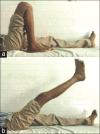Conjoint bicondylar Hoffa fracture in an adult
- PMID: 23798763
- PMCID: PMC3687909
- DOI: 10.4103/0019-5413.111509
Conjoint bicondylar Hoffa fracture in an adult
Abstract
Conjoint bicondylar Hoffa fracture is an extremely rare injury. Only one case has been reported previously in the pediatric age group. We describe this injury in a 17-year-old male who presented following a fall with direct impact on his semiflexed right knee. Plain radiographs were inadequate to define the exact pattern of injury. Computed tomographic (CT) scans demonstrated the coronal fracture involving both the femoral condyles which were joined by a bridge of intact bone. The patient was treated with open reduction and internal fixation using swashbuckler (modified anterior) approach. Union occurred within 3 months and at final followup (at 18 months) the patient had a good clinical outcome. The possible mechanism of injury is discussed.
Keywords: Bicondylar Hoffa fracture; classification; conjoint; swashbuckler approach.
Conflict of interest statement
Figures









References
-
- Hoffa A. Stuttgart: Verlag von Ferdinand Enke; 1904. Lehrbuch der Frakturen und Luxationen; p. 451.
-
- Zeebregts CJ, Zimmerman KW, Ten Duis HJ. Operative treatment of a unilateral bicondylar fracture of the femur. Acta Chir Belg. 2000;100:1104–6. - PubMed
-
- Papadopoulos AX, Panagopoulos A, Karageorgos A, Tyllianakis M. Operative treatment of bilateral bicondylar Hoffa fractures. J Orthop Trauma. 2004;18:119–22. - PubMed
-
- Calmet J, Mellado JM, García Forcada IL, Giné J. Open bicondylar Hoffa fracture associated with extensor mechanism injury. J Orthop Trauma. 2004;18:323–5. - PubMed
-
- Neogi DS, Singh S, Yadav CS, Khan SA. Bicondylar Hoffa fracture-a rarely occurring, commonly missed injury. Injury Extra. 2008;39:296–86.
LinkOut - more resources
Full Text Sources
Other Literature Sources
